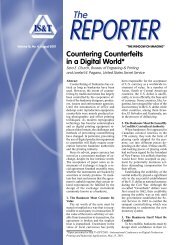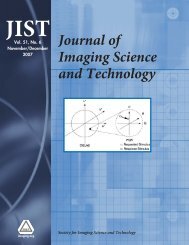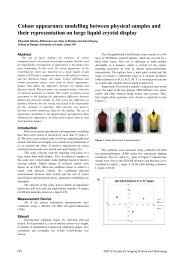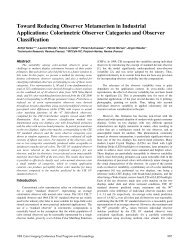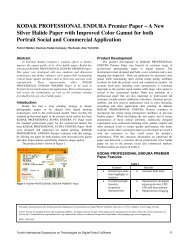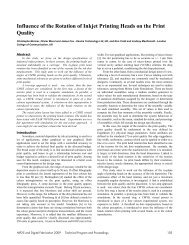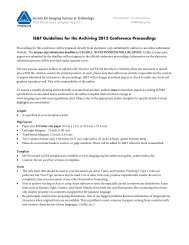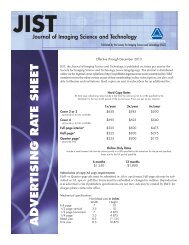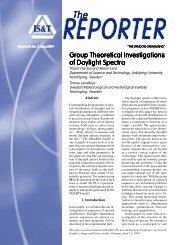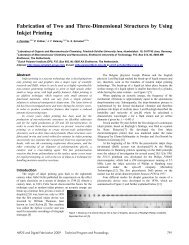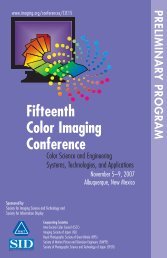Spatio-temporal retinex-like envelope with total variation
Spatio-temporal retinex-like envelope with total variation
Spatio-temporal retinex-like envelope with total variation
Create successful ePaper yourself
Turn your PDF publications into a flip-book with our unique Google optimized e-Paper software.
<strong>Spatio</strong>-Temporal Retinex-<strong>like</strong> Envelope <strong>with</strong> Total Variation<br />
Gabriele Simone and Ivar Farup<br />
Gjøvik University College; Gjøvik, Norway.<br />
Abstract<br />
Many algorithms for spatial color correction of digital images<br />
have been proposed in the past. Some of the most recently<br />
developed algorithms use stochastic sampling of the image in order<br />
to obtain maximum and minimum <strong>envelope</strong> functions. The<br />
<strong>envelope</strong>s are in turn used to guide the color adjustment of the entire<br />
image. In this paper, we propose to use a <strong>variation</strong>al method<br />
instead of the stochastic sampling to compute the <strong>envelope</strong>s. A<br />
numerical scheme for solving the <strong>variation</strong>al equations is outlined,<br />
and we conclude that the <strong>variation</strong>al approach is computationally<br />
more efficient than using stochastic sampling. A perceptual<br />
experiment <strong>with</strong> 20 observers and 13 images is carried out<br />
in order to evaluate the quality of the resulting images <strong>with</strong> the<br />
two approaches. There is no significant difference between the<br />
<strong>variation</strong>al approach and the stochastic sampling when it comes<br />
to overall image quality as judged by the observers. However,<br />
the observed level of noise in the images is significantly reduced<br />
by the <strong>variation</strong>al approach.<br />
Introduction<br />
A great amount of research has been done on Human Visual<br />
System (HVS), which is quite difficult to mimick as the HVS<br />
has complex and robust mechanisms to acquire useful informations<br />
from the physical environment. In particular the color of<br />
an area in a visual scene is heavily influenced by the chromatic<br />
content of the other areas of the scene. This psychophysiological<br />
phenomenon is known as locality of color perception.<br />
One of the earliest models able to deal <strong>with</strong> locality of perception<br />
is Retinex, proposed by Land and McCann in 1971 [14],<br />
which is an image processing method that exhibits some behaviors<br />
similar to the HVS. The scientific community has continued<br />
to be interested in this model and its various applications,<br />
as reported in [17, 16]. In the basic Land and McCann implementation<br />
of Retinex, locality is achieved by long paths scanning<br />
across images. Different implementations and analysis followed<br />
after this first work. These can be divided into two major groups,<br />
andtheydifferinthewaytheyachievelocality. Thefirstgroup<br />
explore the image using paths or computing ratios <strong>with</strong> neighbors<br />
in a multilevel framework [7, 13, 15, 21, 8, 4]. and recent<br />
approaches work using in particular Brownian motions models<br />
[6, 18]. The second group computes values over the image <strong>with</strong><br />
convolution mask or weighting distances [11, 1, 10, 5, 20].<br />
A recent implementation, constructed to investigate the effects<br />
of different spatial samplings, replaces paths <strong>with</strong> random<br />
sprays, i.e. two-dimensional point distributions across the image,<br />
hence the name ”Random Spray Retinex” (RSR) [19]. In<br />
a follow-up, Kolås et al. [12] developed the ”<strong>Spatio</strong>-Temporal<br />
Retinex-<strong>like</strong> Envelope <strong>with</strong> Stochastic Sampling” (STRESS) framework,<br />
where the random sprays are used to calculate two <strong>envelope</strong><br />
functions representing the local reference black and white<br />
points. Both algorithms need a high density of samples in order<br />
to lower the amount of noise, but they never sample the whole<br />
image in order to keep a local effect. Furthermore the number<br />
of sampling points needed increases drastically when increasing<br />
the image size and consequently also the computational time.<br />
In this work, we propose and test an alternative method for<br />
calculating the two <strong>envelope</strong> functions of STRESS, replacing<br />
the the stochasting sampling <strong>with</strong> a constrained <strong>total</strong> <strong>variation</strong><br />
method. We want to emphasize that although much of idea is<br />
the same, it is not just another implementation of STRESS as<br />
the two algorithms follow a different strategy for calculating the<br />
<strong>envelope</strong>s and they show different behaviors.<br />
In order to give to the reader a complete and detailed overview,<br />
STRESS will be described in the next section, followed<br />
by our new proposal. Afterwards, a description of the method<br />
of evaluation of our proposal in addition to some implementation<br />
details are presented. Finally, experimental results are shown and<br />
conclusions are drawn.<br />
The STRESS Algorithm<br />
The STRESS (<strong>Spatio</strong>-Temporal Retinex-<strong>like</strong> Envelope <strong>with</strong><br />
Stochastic Sampling) algorithm developed by Kolås et al. [12]<br />
aims to reproduce some of the adjustment mechanisms typical<br />
for the Human Visual System. The central part of the STRESS<br />
algorithm is to calculate, for each pixel, the local reference black<br />
and white points in each chromatic channel. This is done through<br />
calculating two <strong>envelope</strong> functions, the maximum and minimum<br />
<strong>envelope</strong>s, containing the image signal. The two <strong>envelope</strong>s, denoted<br />
as E max and E min , are slowly varying functions, such that<br />
the image signal is always in between the <strong>envelope</strong>s or equal to<br />
one of them. In particular the two <strong>envelope</strong>s should have the following<br />
characteristics: 1) following the signal; 2) being smooth;<br />
3) being edge preserving; 4) touching the global maximum of the<br />
image for E max , while the global minimum for E min .<br />
For each pixel p 0 , the two <strong>envelope</strong>s are estimated using a<br />
random spray modeled as follows:<br />
where:<br />
E min = p 0 − v r,<br />
E max = p 0 +(1 − v r)=E min + r<br />
r = 1 N<br />
N<br />
∑ r i ,<br />
i=1<br />
v = 1 N<br />
N<br />
∑ v i<br />
i=1<br />
(1a)<br />
(1b)<br />
(2a)<br />
(2b)<br />
N denotes the number of iterations, while r i is the range of the<br />
samples and v i the relative value of the center pixel given as:<br />
r i = s max<br />
i − s min<br />
i , (3a)<br />
{ 12 if r i = 0<br />
v i = p 0 −s min<br />
(3b)<br />
i<br />
r i<br />
else<br />
176 ©2012 Society for Imaging Science and Technology
s max<br />
i and s min<br />
i are the maximum and minimum samples, found as:<br />
s max<br />
i =<br />
s min<br />
i =<br />
max p j<br />
j ∈{1,2,...,M} ,<br />
min p j<br />
j ∈{1,2,...,M}<br />
(4a)<br />
(4b)<br />
where M is the number of samples and p i is the pixel at iteration i.<br />
Given the two <strong>envelope</strong>s, each pixel p 0 is adjusted as follows:<br />
p stress =<br />
p 0 − E min<br />
E max − E min<br />
(5)<br />
In this way STRESS aims to enhance the contrast of the<br />
image, giving highlight/emphasis to details and balance the three<br />
channels of the image, thus performing a color correction.<br />
Our Proposal: The STRETV Algorithm<br />
The main feature of the STRESS algorithm is the calculation<br />
of the <strong>envelope</strong>s E max and E min for each channel. In our<br />
proposal the stochastic sample is replaced <strong>with</strong> the <strong>total</strong> <strong>variation</strong><br />
method for calculating the two <strong>envelope</strong>s. The following<br />
equation describes our model, called STRETV (<strong>Spatio</strong>-Temporal<br />
Retinex-<strong>like</strong> Envelope <strong>with</strong> Total Variation):<br />
∫<br />
minimize TV = minimize | ∇E | dΩ+ λ ∫<br />
| E −I | 2 dΩ (6)<br />
Ω<br />
2 Ω<br />
where I is the original image channel, E is the maximum or minimum<br />
<strong>envelope</strong>, Ω is the domain of the image, ∫ Ω | ∇E | dΩ is the<br />
<strong>total</strong> <strong>variation</strong>al term, and λ ∫<br />
2 Ω | E − I |2 dΩ is the non-smooth<br />
fidelity term <strong>with</strong> λ weighting factor for the data attachment.<br />
This minimization is subject to the three following constraints:<br />
following the signal, E max ≥ I and E min ≤ I. The corresponding<br />
Euler-Lagrange equation is as follows:<br />
( ) ∇E<br />
∇ · − λ(E − I)=0 (7)<br />
‖ ∇E ‖<br />
where I is the original( image)<br />
channel, E is the maximum and<br />
minimum <strong>envelope</strong>, ∇· ∇E<br />
‖∇E‖ is the driving force to the smoothness,<br />
and λ(E −I) is the driving force to the data attachment <strong>with</strong><br />
0 < λ ≪ 1.<br />
The solution is computed using an Euler explicit time marching<br />
scheme for each color channel:<br />
( ) ∇E<br />
∇ · − λ(E − I)= ∂E<br />
(8)<br />
‖ ∇E ‖<br />
∂t<br />
applying Neumann boundary conditions and the regularization<br />
proposed by Blomgren and Chan [2] at each iteration. At end<br />
of each iteration the constraints are enforced in order to avoid<br />
numerical errors.<br />
Results<br />
Preliminary tests indicate that STRETV works well <strong>with</strong><br />
λ = 0.1 andλ = 0.001, using a unit time step (Δt = 1). The<br />
algorithm has been implemented in Matlab (using Parallel Computing<br />
Toolbox) and tested on a DELL Latitude Model E6520.<br />
In order to evaluate the quality of STRETV, two perceptual<br />
experiments have been carried out. A set of 13 images chosen<br />
following the recommendations from [9, 3] were evaluated in a<br />
pairwise comparison on neutral grey background to a <strong>total</strong> of 20<br />
observers. In the first perceptual experiment each STRETV image<br />
was compared to its original and the observers were asked<br />
to choose the image based on their preference. In the second<br />
perceptual experiment each STRETV image was compared to its<br />
relative processed <strong>with</strong> STRESS and in a first round the observers<br />
were asked to choose the image based on their preference while<br />
in a second round they were asked to pick the image <strong>with</strong> more<br />
noise. Whenever the STRETV image did not succeed in the first<br />
experiment, it was discarded from the second experiment.<br />
Figure 1-2 shows the 13 original images in the middle, the<br />
corresponding processed by STRETV on the right and the corresponding<br />
processed by STRESS on the left. Due to page limitations,<br />
it is not possible to analyze all the images but particular<br />
interesting results for STRETV can be found in Figures 1(c), 2(l),<br />
2(r) where the reflections present in the water, windows and eyeglasses<br />
respectively are more visible and in Figure 2(o) where<br />
the red component is corrected and identification of objects in<br />
the map are perceptually easier.<br />
Figure 3 shows the preference of the 20 observers on the<br />
tested images for the first psychophysical experiment and we can<br />
clearly see that STRETV succeeds on 11 of 13 images <strong>with</strong> six<br />
of them <strong>with</strong> a preference equal or greater than 85% of the rates.<br />
The reason of the defeat for Figure 1(i) and of the draw for Figure<br />
2(f) <strong>with</strong> respect to their original can be found in the fact that<br />
observers perceived a loss of naturalness.<br />
Figure 4 shows the preference of the 20 observers for the<br />
second psychophysical experiment, where STRETV was compared<br />
to STRESS. Figure 5 shows the perceived noise of the 20<br />
observers for STRETV and STRESS. STRETV is preferred for<br />
7 of the 11 images and it results to be less noisy for 9 of the 11<br />
images.<br />
Furthermore, STRETV has lower computational complexity<br />
than STRESS, O(N · n) against O(N · M · n), whereN is the<br />
number of iterations, n is the number of pixels in the image and<br />
M is the number of samples. As consequence STRETV is faster<br />
than STRESS implemented in MATLAB. On the other hand a<br />
new implementation of STRESS in CUDA provided by the original<br />
authors [12] is more efficient than STRETV.<br />
A sign-test at 95% confident interval shows that STRETV<br />
is significantly better than the original and having the same performance<br />
of STRESS but producing images less noisy.<br />
Conclusions<br />
We have developed a new Retinex algorithm called STRETV<br />
(<strong>Spatio</strong>-Temporal Retinex-<strong>like</strong> Envelope <strong>with</strong> Total Variation),<br />
following the approach of Kolås et al. [12] for the STRESS algorithm<br />
(<strong>Spatio</strong>-Temporal Retinex-<strong>like</strong> Envelope <strong>with</strong> Stochastic<br />
Sampling), which adjusts each pixel calculating the local reference<br />
of lighter and darker points in each channel. This is done<br />
estimating two <strong>envelope</strong> functions, the maximum and minimum<br />
<strong>envelope</strong>s, containing the image signal, through the <strong>total</strong> <strong>variation</strong><br />
method.<br />
STRETV shows promising results in contrast enhancement<br />
and automatic color correction. A first psychophysical experiment<br />
on 13 images <strong>with</strong> 20 observers confirm the efficiency of<br />
the method <strong>with</strong> a noticeable success of STRETV on 11 images<br />
in comparison to the original. A second psychophysical experiment<br />
shows that the overall performance of STRESS is not significantly<br />
different at 95% confidence level. At the same time a<br />
higher preference of the observers of STRETV <strong>with</strong> respect to<br />
STRESS is noticed due to a lower perception of noise.<br />
Future work can consist of extending STRETV to high dynamic<br />
range imaging rendering and color-to-grey conversion to<br />
CGIV 2012 Final Program and Proceedings 177
(a) (b) (c)<br />
(d) (e) (f)<br />
(g) (h) (i)<br />
(j) (k) (l)<br />
(m) (n) (o)<br />
Figure 1.<br />
STRESS on the left, original in the middle, STRETV on the right.<br />
(p) (q) (r)<br />
178 ©2012 Society for Imaging Science and Technology
(a) (b) (c)<br />
(d) (e) (f)<br />
(g) (h) (i)<br />
(j) (k) (l)<br />
(m) (n) (o)<br />
(p) (q) (r)<br />
Figure 2.<br />
(s) (t) (u)<br />
STRESS on the left, original in the middle, STRETV on the right.<br />
CGIV 2012 Final Program and Proceedings 179
Figure 3. Observer’s preference of STRETV <strong>with</strong> respect to its original on the 13<br />
tested images.<br />
Figure 5.<br />
images.<br />
Observer’s perceived noise of STRETV and STRESS on the 11 tested<br />
Figure 4. Observer’s preference of STRETV in respect of STRESS on the 11<br />
tested images.<br />
be fully comparable <strong>with</strong> the STRESS and other spatial color algorithms.<br />
Acknowledgment<br />
This work has been supported by NFR over the SHP project.<br />
The authors would <strong>like</strong> to thank Fritz Albregtsen (University of<br />
Oslo) for his useful feedbacks and suggestions.<br />
References<br />
[1] K. Barnard and B. Funt. Investigations into multi-scale<br />
Retinex. In Color Imaging in Multimedia, pages 9–17.<br />
Technology, Wiley, 1998.<br />
[2] P. Blomgren and T. F. Chan. Color TV: Total <strong>variation</strong><br />
methods for restoration of vector-valued images. IEEE<br />
Transactions on Image Processing, (7):304–309, 1998.<br />
[3] CIE. Guidelines for the evaluation of gamut mapping algorithms.<br />
Technical Report ISBN: 3-901-906-26-6, CIE<br />
TC8-08, 156:2004.<br />
[4] T. J. Cooper and F. A. Baqai. Analysis and extensions of the<br />
frankle-mccann Retinex algorithm. Journal of Electronic<br />
Imaging, 13(1):85–92, 2004.<br />
[5] J.D.CowanandP.C.Bressloff. Visual cortex and the<br />
Retinex algorithm, volume SPIE-4662, pages 278–285.<br />
The International Society for Optical Engineering, 2002.<br />
[6] G. Finlayson, S. Hordley, and M. Drew. Removing shadows<br />
from images using Retinex. In The Tenth Color Imaging<br />
Conference: Color Science and Engineering Systems,<br />
Technologies, Applications, pages 73–79, Scottsdale, AZ,<br />
USA, November 2002. IS&T/SID.<br />
[7] J. Frankle and J. McCann. Method and apparatus for lightness<br />
imaging. United States Patent No. 4,384,336, 1983.<br />
[8] B.Funt,F.Ciurea,andJ.J.McCann.RetinexinMATLAB.<br />
Journal of Electronic Imaging, 13(1):48–57, January 2004.<br />
[9] J. Holm, I. Tastl, and T. Johnson. Definition & use of the<br />
iso 12640-3 reference color gamut. In Fourteenth Color<br />
Imaging Conference: Color Science and Engineering Systems,<br />
Technologies, Applications, pages 62–68, Scottsdale,<br />
AZ, 2006. IS&T/SID.<br />
[10] F. O. Huck, C. L. Fales, R. E. Davis, and R. Alter-<br />
Gartenberg. Visual communication <strong>with</strong> Retinex coding.<br />
Applied Optics, 39(11):1711–1730, 2000.<br />
[11] D. J. Jobson, Z. Rahman, and G. A. Woodell. Properties<br />
and performance of a center/surround Retinex. IEEE Transactions<br />
on Image Processing, 6(3):451–462, 1997.<br />
[12] Ø. Kolås, I. Farup, and A. Rizzi. STRESS: A framework<br />
for spatial color algorithms. Journal of Imaging Science<br />
and Technology, 55(4):040503, 2011.<br />
[13] E. H. Land. The Retinex theory of color vision. Scientific<br />
American, 237:108–128, 1977.<br />
[14] E. H. Land and J. J. McCann. Lightness and Retinex theory.<br />
Journal of the Optical Society of America, 61(1):1–11, jan<br />
1971.<br />
[15] D. Marini and A. Rizzi. A computational approach to color<br />
adaptation effects. Image and Vision Computing, 18:1005–<br />
1014, 2000.<br />
[16] J. McCann and A. Rizzi. The Art and Science of HDR Imaging.<br />
John Wiley, 2011. ISBN: 978-0-470-66622-7.<br />
[17] J. J. McCann. Guest editorial: Special section on Retinex<br />
at 40. Journal of Electronic Imaging, 13(1):6–7, 2004.<br />
[18] R. Montagna and G. D. Finlayson. Constrained pseudobrownian<br />
motion and its application to image enhancement.<br />
Journal of the Optical Society of America A, 28(8):1677–<br />
1688, August 2011.<br />
[19] E.Provenzi,M.Fierro,A.Rizzi,L.D.Carli,D.Gadia,and<br />
D. Marini. Random spray Retinex: A new Retinex implementation<br />
to investigate the local properties of the model.<br />
180 ©2012 Society for Imaging Science and Technology
IEEE Transactions on Image Processing, 16(1):162–171,<br />
January 2007.<br />
[20] Z. Rahman and G. A. Woodell. Retinex processing for automatic<br />
image enhancement. Journal of Electronic Imaging,<br />
13:100–110, 2004.<br />
[21] A. Rizzi, D. Marini, and L. D. Carli. LUT and multilevel<br />
brownian Retinex colour correction. Machine Graphics &<br />
Vision, 11(1):153–169, 2002.<br />
Author Biography<br />
Gabriele Simone received his BiT in 2005, and his MSIT<br />
in 2007 both at University of Milan - Department of Information<br />
Technology, Italy. He is currently pursuing a PhD in Color<br />
Imaging. He is a member of the Norwegian Color Research Laboratory<br />
at Gjøvik University College and his main research topic<br />
is contrast measure, image difference metrics, and tone mapping<br />
algorithms in HDR images.<br />
Ivar Farup received the M.Sc. degree in physics from the<br />
Norwegian University of Science and Technology, Trondheim,<br />
Norway, in 1994, and the Ph.D. degree in applied mathematics<br />
from the University of Oslo, Oslo, Norway, in 2000. Since 2000,<br />
he has been an Associate Professor at Gjøvik University College,<br />
Gjøvik, Norway, mainly focusing on color imaging.<br />
CGIV 2012 Final Program and Proceedings 181




